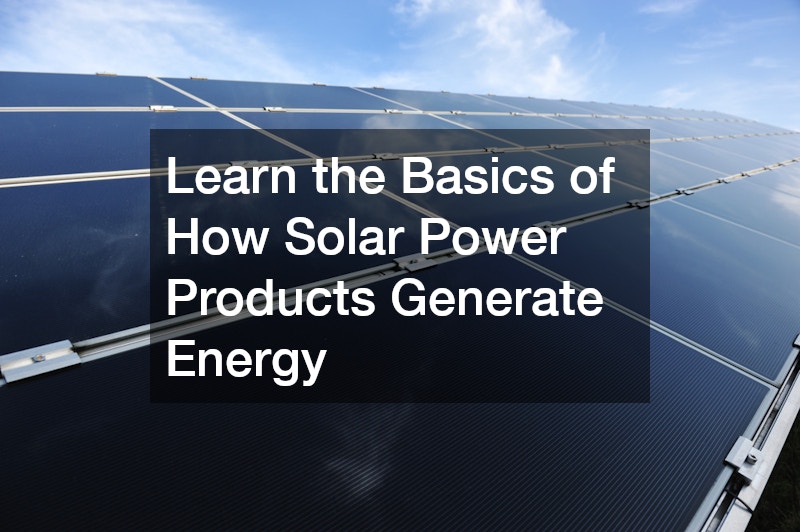Explore the fundamentals of solar power products and how they generate energy, and find answers to some of the most frequently asked questions to help you understand this renewable energy resource better.
What Are Solar Power Products?
Solar power products typically include solar panels, inverters, batteries, and other components that work together to harness sunlight and convert it into usable energy. Solar panels, made up of photovoltaic cells, are the most recognizable component, capturing solar energy.
Inverters are essential for converting the electricity generated by solar panels into a usable form for homes and businesses.
Additionally, batteries play a crucial role by storing excess energy generated during sunny periods for use when sunlight is not available. These products are designed to work in tandem to create an efficient and effective solar power system. Together, these components make it possible for households and businesses to tap into renewable energy sources.
The integration of advanced technologies has also led to the development of other solar products, including solar water heaters and solar trackers. These innovations complement the traditional solar power systems, offering more options for consumers looking to reduce their carbon footprint. With such a diverse range of products available, consumers can choose the solutions that best suit their energy needs and budget.
How Do Solar Panels Work?
Solar panels generate electricity through the photovoltaic effect, a phenomenon that occurs when light photons strike the surface of semiconductor materials within the solar cells. When sunlight hits these materials, it excites electrons, creating an electric current. This process is fundamental to how solar panels function and directly impacts their efficiency and energy output.
The solar panels consist of multiple layers that help to capture and convert sunlight into electricity. The top layer is typically a glass sheet that protects the solar cells underneath, while the base layer is often made from materials like silicon that effectively convert the sunlight. The arrangement and quality of these layers significantly influence the overall performance of the solar panel.
Once the solar cells generate DC electricity, it is then directed into an inverter for conversion into AC electricity. The effectiveness of this conversion is crucial, as most homes and businesses rely on AC electricity to power their appliances. Thus, understanding how solar panels work provides insight into the broader mechanisms of solar energy generation and its applications in everyday life.
What Is the Role of an Inverter in Solar Power Systems?
The inverter is often referred to as the brain of the solar power system, playing a pivotal role in converting the DC electricity produced by solar panels into AC electricity. This conversion is essential because most household appliances and the electrical grid operate on AC electricity. Without an inverter, the energy generated by solar panels would be unusable for common applications.
Additionally, inverters also monitor the performance of the solar power system, ensuring that each component operates efficiently. They can detect issues such as energy production fluctuations or faults within the system, providing real-time data to users or maintenance personnel. This functionality is critical for optimizing energy generation and maximizing savings for homeowners.
The advancement of inverter technology has led to the development of smart inverters that can communicate with the grid, integrate energy storage solutions, and even allow for remote monitoring. These innovations present opportunities for more efficient energy management and smoother integration of solar energy into the broader energy landscape. Understanding the role of inverters helps demystify an essential component of solar power systems and highlights its importance in the renewable energy ecosystem.
How Is Solar Energy Stored for Later Use?
Storing solar energy is a critical aspect of maximizing the benefits of solar power systems. The common solution for this is through the use of batteries, which allow homeowners to store excess energy generated during peak sunlight hours. This stored energy can then be used during nighttime or cloudy days, ensuring a continuous power supply without relying on the grid.
Different types of batteries are available for solar energy storage, including lithium-ion, lead-acid, and emerging technologies like solid-state batteries. Each type has its advantages and disadvantages, affecting factors like cost, lifespan, and efficiency. As technology advances, more efficient and cost-effective options continue to emerge, making solar energy storage increasingly accessible to a broader audience.
In addition to batteries, other energy storage technologies such as pumped hydro storage and thermal energy storage are being explored. These non-battery solutions can also help manage energy supply and demand effectively. The ability to store solar energy not only enhances energy independence for users but also contributes to a more robust and sustainable energy grid. Understanding storage solutions is essential for homeowners and businesses looking to optimize their solar power systems.
What Are the Benefits of Using Solar Power Products?
The benefits of solar power products extend well beyond their initial installation costs. One of the primary advantages is their positive impact on the environment. By utilizing solar energy, users can significantly reduce their carbon emissions and dependence on fossil fuels, contributing to a cleaner and more sustainable planet. This shift towards renewable energy is crucial in combating climate change.
Additionally, solar power products can lead to substantial cost savings over time. While the upfront investment can be significant, the savings on electricity bills and potential tax incentives can provide financial relief in the long run. Many users find that their return on investment makes solar power a financially sound choice, especially in regions with high electricity rates or abundant sunlight.
Lastly, investing in solar power products provides energy independence. Homeowners can generate their own electricity, reducing reliance on the grid and insulating themselves from rising energy costs. This shift allows users to become more resilient against fluctuations in energy prices and helps promote a decentralized energy system. Understanding these benefits is vital for anyone considering the transition to solar energy and can serve as motivation for making the switch.
Understanding the basics of how solar power products generate energy is essential for anyone considering making the switch to renewable energy solutions. With advancements in technology, solar power continues to offer a viable and sustainable energy source for the future.




